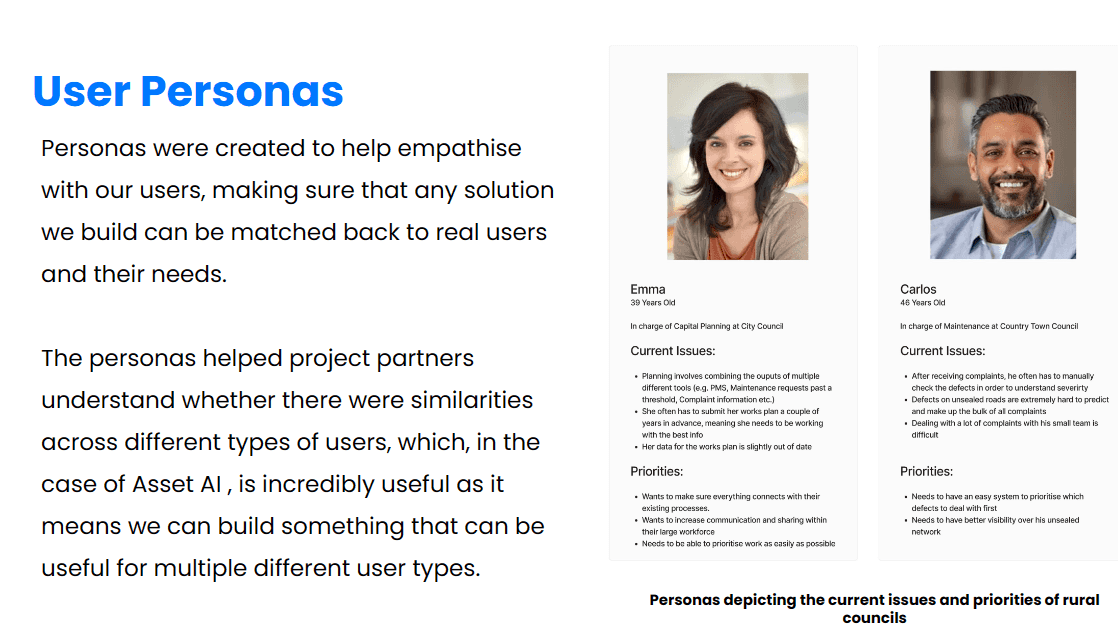Asset AI Discovery

Partner

Background
User Research guides the development of a proactive road maintenance tool.
WHAT IS ASSET AI?
Asset AI is a digital tool that will help all levels of government have an overview of the condition of the New South Wales (NSW) road network in real time. Importantly, it will help streamline road maintenance planning and reduce costs. Asset AI will enable a proactive, risk-based early intervention approach to maintenance and improve road safety outcomes. Code for Australia was commissioned to run the Pre-Discovery and Discovery phases of the project - conducting user research and technical feasibility studies with councils across NSW and providing advice on the tool's architecture and design based on the research.
Code for Australia partnered with Transport for NSW (TfNSW), Institute of Public Works Engineering Australasia (IPWEA) NSW’s Roads & Transport Directorate, and the City of Canterbury-Bankstown to help the project partners align on scope while championing the use of agile and design-led practices in project delivery. By recommending a user research-led approach to product development, we were able to help our partners understand the needs of varied user groups and prioritise features based on those insights.
This project was funded under the NSW Digital Restart Fund and delivered by Code for Australia, with methodology informed by the NSW Design Standard.
THE CODE FOR AUSTRALIA APPROACH
Our advisors conducted comprehensive user research with councils around NSW to map their technical capabilities and requirements for the new tool, as well as current processes and expectations of Asset AI.
Interviews were conducted with asset managers from twelve regional and metro councils across NSW.
Some of the main concepts that we wanted to understand from the research were:
The nature of their work and current tools and processes
What teams do within these councils
How defects are addressed
Insight into the difficulties they currently face
How complications are dealt with
Blue sky thinking - what their ideal solution might look like
Technical Advisors were present at all sessions with Councils to understand the range of current practices and requirements. This allowed the team to make implementation recommendations based on the needs of actual users of Asset AI, allowing usability constraints to be determined and solved in the Discovery phase rather than later.
By continuously advocating for user needs over business requirements, our Advisors mitigated the risk of choosing the wrong technology and developing the wrong features while building important relationships with Councils around the State. To help achieve this, the Code for Australia team created a series of 'user personas' to help refer to users in the first person, therefore keeping them front of mind.
The team worked throughout the engagement to build internal capability, ensuring the next phase of work could be delivered seamlessly, and the project partners would be empowered to utilise design-led practices in future product delivery.

CODE FOR AUSTRALIA RESULTS
Our deliverables across the Pre-Discovery and Discovery Phases included:
Discovery Report - This report features interviews with councils from across NSW. It outlines the expectations of how councils will use and access the tool and the features they require. Code for Australia also developed a series of user experience and technical recommendations for the product to be developed.
Delivery Plan - Defines the tasks and dependencies required to deliver the project's scope and our recommendations on team structure and delivery methodology.
Data Requirements Report Based on user research, the Code for Australia outlined the minimum data requirements needed to meet user expectations.
Product Roadmap and Feature Backlog - These deliverables outlined the development of the product in subsequent phases
The Discovery activities saw our team uncover user challenges, behaviours and motivations and gain a better insight into the current service landscape including technical infrastructure and systems.
This, in turn, helped the Code for Australia Advisors to define, prioritise and determine design solutions that should be further tested and validated in the proceeding Delivery phases.



